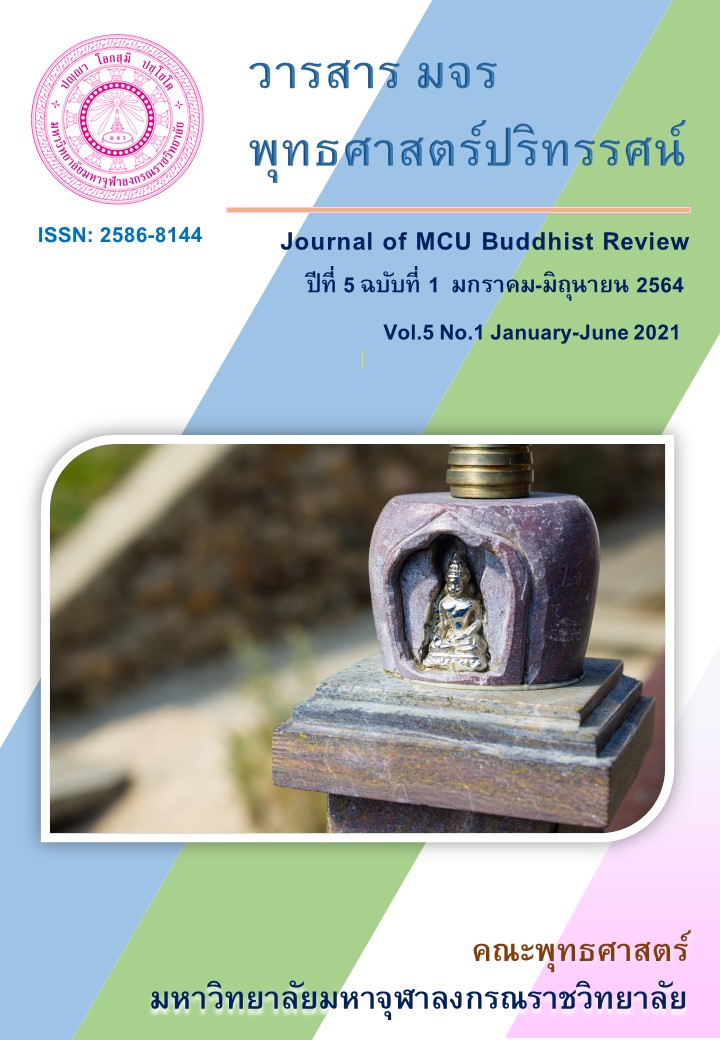การสร้างสันติบนความขัดแย้งทางความคิดในพระพุทธศาสนาเถรวาท
Main Article Content
บทคัดย่อ
บทความนี้มีวัตถุประสงค์เพื่อศึกษาความขัดแย้งทางความคิดในพระพุทธศาสนาเถรวาทและศึกษาการสร้างสันติภาพบนความขัดแย้งทางความคิดในพระพุทธศาสนาเถรวาท ด้วยการศึกษาทางด้านเอกสาร ผลการศึกษาพบว่า ความขัดแย้งทางความคิดเกิดจากอกุศลมูลนำไปสู่การถือตัวตนและความเห็นที่แตกต่างกันขึ้นภายใน เกิดการสร้างกลุ่มก้อนที่เป็นตัวเป็นตนขึ้นระหว่างผู้มีอำนาจกับคนที่อยู่ใต้อำนาจ ผสมผสานกับปัจจัยภายนอก คือ ข้อเท็จจริง ความสัมพันธ์ ผลประโยชน์ ค่านิยม และวิธีการสร้างสันติภาพบนความขัดแย้งทางความคิดในพระพุทธศาสนาเถรวาทคือ 1. การสร้างความเสมอภาคพื้นฐาน สังคมจะต้องใช้วินัย หรือกฎหมายให้มีลักษณะการเชื่อมโยงระหว่างกันด้วยระเบียบวินัย เมื่อไม่รักษากฎเกณฑ์กติการะเบียบวินัยของสังคมก็ไม่สามารถนำไปสู่ความสงบได้ ความเป็นระเบียบวินัย สำหรับสังคมประชาธิปไตย เป็นลักษณะอันแสดงถึงความสามารถในการปกครองตนเองได้ โดยสังคมที่ดีต้องมีกติกา และคนสังคมต้องรักษากติกานั้นโดยมีความเสมอภาค คือเท่าเทียมกันต่อหน้ากฎหมาย 2) การมีระบบสังคมที่เอื้อธรรม เป็นการนำหลักธรรมมาใช้เพื่อแก้ไขปัญหา โดยวางหลักธรรมเป็นเกณฑ์ทางสังคม เน้นพระธรรมอันถูกต้อง โดยเน้นหลักธรรมสัจจะที่เป็นหลักธรรมชาติ ไม่ใช่สิ่งที่มนุษย์คิดเองพูดเอง แต่เป็นธรรมที่เป็นไปตามเจตนารมณ์ของธรรมชาติ
Article Details
- บทความที่ได้รับการตีพิมพ์เป็นลิขสิทธิ์ของวารสาร มจร พุทธศาสตร์ปริทรรศน์
- ข้อความใดๆ ที่ปรากฎในบทความที่ได้รับการตีพิมพ์ในวารสาร ถือเป็นความรับผิดชอบของผู้เขียนบทความ และข้อคิดเห็นนั้นไม่ถือว่าเป็นทัศนะและความรับผิดชอบของกองบรรณาธิการวารสาร มจร พุทธศาสตร์ปริทรรศน์
เอกสารอ้างอิง
คณะกรรมการกองตำรา มหามกุฏราชวิทยาลัย. (2530). วินัยวินิจฉัย. กรุงเทพมหานคร: โรงพิมพ์มหามกุฏราชวิทยาลัย.
ธนาชัย สุขวณิช. (2555). ประมวลเหตุการณ์ความขัดแย้งในสังคมไทยและแนวทางแก้ไทย. กรุงเทพมหานคร: สำนักพิมพ์ปัญญาชน.
พระธรรมโกศาจารย์ (พุทธทาส). (2536). มองสันติภาพของโลก. กรุงเทพมหานคร: โรงพิมพ์ธรรมสภา.
พุทธทาสภิกขุ. (2548). ธัมมิกสังคมนิยม. กรุงเทพมหานคร: สุขภาพใจ.
พระธรรมกิตติวงศ์ (ทองดี สุรเตโช). (2551). คำวัด. พิมพ์ครั้งที่ 3. กรุงเทพมหานคร: ธรรมสภา.
พระพรหมคุณาภรณ์ (ป.อ. ปยุตฺโต). (2551). พจนานุกรมพุทธศาสน์ ฉบับประมวลศัพท์. พิมพ์ครั้งที่ 11. กรุงเทพมหานคร: เอส. อาร์. พริ้นติ้ง แมสโปรดักส์.
พระพรหมคุณาภรณ์ (ป.อ.ปยุตฺโต). (2557). ประชาธิปไตยจริงแท้ คือแค่ไหน. พิมพ์ครั้งที่ 6. กรุงเทพมหานคร: สำนักพิมพ์ผลิธัมม์.
พระมหาหรรษา ธมฺมหาโส (นิธิบุณยากร). (2554). พุทธสันติวิธี: การบูรณาการหลักการและเครื่องมือจัดการความขัดแย้ง. กรุงเทพมหานคร: บริษัท 21 เซ็นจูรี่ จำกัด.
พระมหาหรรษา ธมฺมหาโส (นิธิบุณยากร). (2547). “รูปแบบการจัดการความขัดแย้งโดยพุทธสันติวิธี กรณีลุ่มนํ้าแม่ตาช้าง จ.เชียงใหม่”. วิทยานิพนธ์ดุษฎีนิพนธ์ สาขาวิชาพระพุทธศาสนา. บัณฑิตวิทยาลัย: มหาวิทยาลัยมหาจุฬาลงกรณราชวิทยาลัย.
มหาจุฬาลงกรณราชวิทยาลัย. (2539). พระไตรปิฎกภาษาไทย ฉบับมหาจุฬาลงกรณราชวิทยาลัย. กรุงเทพมหานคร: โรงพิมพ์มหาจุฬาลงกรณราชวิทยาลัย.
ราชบัณฑิตยสถาน. (2546). พจนานุกรมฉบับราชบัณฑิตยสถาน พ.ศ. 2542. กรุงเทพมหานคร: นานมีบุคส์พับลิเคชันส์.
สมเด็จพระมหาสมณเจ้า กรมพระยาวชิรญาณวโรรส. (2541). วินัยมุข เล่ม 1. กรุงเทพมหานคร: โรงพิมพ์มหามกุฏราชวิทยาลัย.


